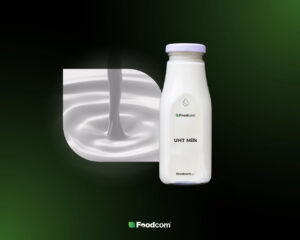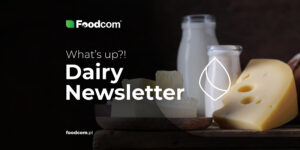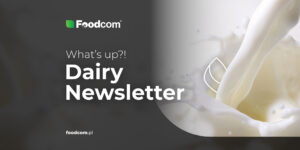- Rising prices for SMP, butter and SWP: Global demand and limited supply are leading to higher prices, with further increases forecast for 2025.
- Stable cheese prices: Che ese prices, while stable, may indicate market saturation, with high international demand.
- Australia’s export adaptation: Australian producers are diversifying markets, reducing reliance on China and increasing exports to Asia and the Middle East.
- Innovative vaccine in the UK: A new vaccine against Mycoplasma bovis increases calf immunity, supporting herd health and antibiotic reduction.
Welcome Partners!
Welcome back to our newsletter!
In this newsletter, we look at the latest trends in the dairy sector as we approach the end of the year. As the prices of Skimmed Milk Powder, Butter and Sweet Whey Powder rise, market dynamics reveal increasing global demand and limited supply, leading to projected price increases in 2025. We discuss everything from the stable but strong prices of Cheese to the fluctuating prices of Cream and Skimmed Milk Concentrate, giving a complete picture of the current dairy market landscape.
Let’s see what else has happened in the dairy market recently!
Milk powder
Prices for Skimmed Milk Powder (SMP) for feed have recently recorded an increase, with forecasts for Q4 at around €2500/MT. Forecasts for Q1 2025 suggest a further increase, potentially reaching €2550/MT. Despite these increases, finding interested buyers has been a challenge, indicating some market resistance to current price levels. Globally, SMP prices are on an upward trend, with an average price of around €2,850/MT, reflecting continued global demand.
SMP for food applications is also on a similar upward trend, with prices at or above EUR 2,500/MT. This increase reflects continued demand from the food industry, which is willing to accept higher prices due to limited supply.
Cheese
Cheese prices, including popular varieties such as Gouda and Edam, remain stable with offers in the €4500-4750/MT range. However, attracting additional buyers has been a challenge, which may indicate that the market is approaching saturation or that buyers are cautious about increased prices. Cheese prices on the international market continue to rise, averaging around €4973/MT, suggesting a general upward trend driven by strong demand from various markets.
Fats
Butter prices in Europe have increased in recent days, mainly due to an increase in the cost of cream, which has already exceeded the EUR 10,000/MT level. Butter stocks remain low because much of the milk fat is still sold as cream rather than being made into butter. This leads to a backwardation (backwardation) market, where prices for immediate deliveries are higher than future deliveries, prompting both buyers and sellers to maintain minimum stock levels.
In the US, the butter market is more stable, with sufficient stocks and production levels, keeping prices below $3/lb. In Oceania, on the other hand, butter prices have risen sharply at recent auctions due to strong demand from regions such as the Middle East and North Asia. Butter prices in the US are expected to remain stable, while in Europe and Oceania they may increase as we approach the end of the year. Although cream prices in Europe may decline slightly by the end of the month, limited butter supplies may keep prices largely unchanged.
Liquids
Cream prices continue to rise, currently reaching €10400-10600/MT on an FCA basis. This increase is equivalent to a butter price of around €8850/MT and is likely to be driven by limited cream supply and rising demand, particularly in the run-up to Christmas.
The Skimmed Milk Concentrate market remains strong, with prices in the range of EUR 2350 to 2400/MT on an FCA basis in Germany. However, some deals for ‘Christmas week’ were made at much lower prices, around EUR 1850/MT, for shipments to the Netherlands, with deliveries from France or the UK. This price discrepancy most likely reflects seasonal purchasing patterns or specific short-term contracts that influence prices during periods of high demand.
Milk spot prices remain high, staying above EUR 62/MT per 100 kg. Higher payments to farmers are likely to encourage higher production levels, although production costs continue to play a key role in supply planning for the coming months.
Whey powder
Sweet Whey Powder (SWP) prices have increased, with offers for Q4 ranging from €890 to €900/MT. Looking ahead, for Q1 2025 prices have increased further, reaching levels of EUR 930/MT or higher. This increase reflects both strong demand and limited supply, especially as Q1 prices typically signal expectations of tighter conditions or continued price strength. In the WPC 80 market, prices remain stable at around €10,500/MT in Europe, while the US market is trading at levels around €9586/MT, suggesting a stable outlook ahead of seasonal change. For WPI, which continues to maintain high prices, demand remains solid, supporting strong rates in the EUR 16,000-17,000/MT range.
What else
Oceania
Despite a decline in demand for dairy products in China, Australia has seen its dairy exports increase, effectively diversifying its markets. Australian producers, adapting to changing trading conditions, have expanded exports to new markets in Asia and the Middle East, reducing their dependence on China. This flexible export model has enabled Australia to not only survive difficult times, but to continue to grow. In the face of global economic challenges and market volatility, the Australian dairy sector is demonstrating the importance of being able to adapt quickly and export strategies based on diversification.
Europe
An innovative vaccine targeting Mycoplasma bovis, a serious pathogen that affects the health and productivity of dairy herds, has been launched in the UK. The new formulation, available for use from day 7 in calves, requires a booster dose after 21 days and immunity develops after just a further 12 days following the booster. Mycoplasma bovis is one of the main causes of respiratory disease and udder inflammation, resulting in serious economic losses. The introduction of the vaccine is expected to help UK farmers to effectively protect their herds, reduce calf mortality and reduce the need for antibiotics, which is important in the context of reducing bacterial resistance.
![Dairy market growth: strong demand and price rises for the end of 2024 [244th Edition of DAIRY Newsletter] Dairy market growth: strong demand and price rises for the end of 2024 [244th Edition of DAIRY Newsletter]](https://foodcom.pl/wp-content/uploads/2023/08/Foodcom_SA_Whats_up_Dairy_Newsletter-1520x760.jpg)






